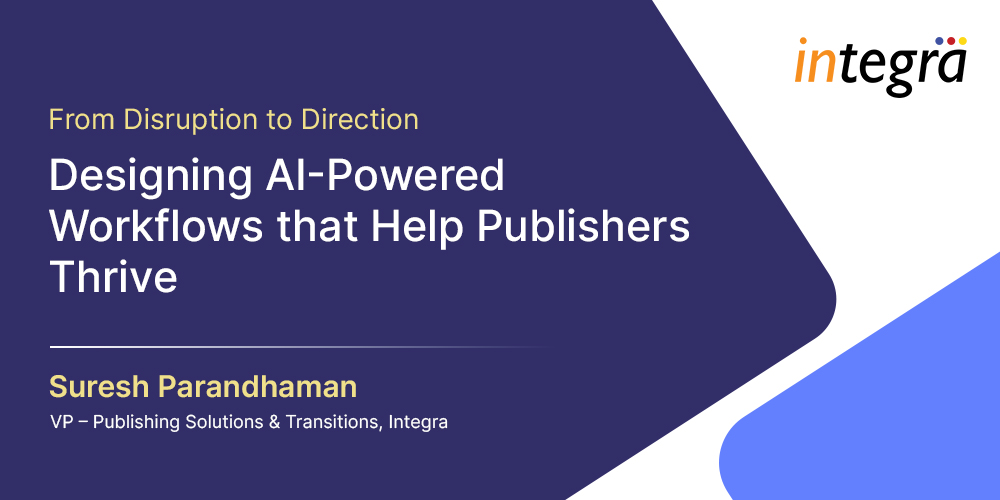AI–Human Collaboration Will Redefine Education Design and Publishing in 2026

From Hype to Harmony (2023 → 2026)
In November 2023, we explored how AI-human collaboration could expand the frontiers of education content development, highlighting the potential of generative AI to reshape pedagogy, learning, and authorship. Back then, the conversation focused on how AI in education might transform classrooms, content curation, and personalized learning pathways.
As 2025 closes and we step into 2026, that potential has moved from theory to practice. 2026 will mark the inflection point where AI-human collaboration in education will move from tactical pilots to structural practice.
Across classrooms and content developers, artificial intelligence is evolving from passive support to intelligent collaboration, transforming the relationship between human creativity and machine precision.
Recent studies confirm measurable progress:
- 64% of teachers report AI tools improve the quality of tailored materials
- AI-enabled adaptive systems have boosted test performance by 62%
- Educators save nearly six hours weekly through AI-assisted workflows
Together, these gains mark a shift from efficiency to augmentation, setting the stage for a new era of intelligent human–AI collaboration. Building on the ideas we had first explored in 2023 this article looks ahead to how these rapid advances will shape the next generation of human-centered education design in 2026 and beyond.
The Collaborative Classroom: AI Teaching Tools in Action
Education is poised to enter an era of collaborative intelligence, where human experts and AI systems teach in partnership, not competition. AI-embedded ecosystems will connect teachers, students, and algorithms into dynamic learning networks, turning classrooms into adaptive, data-aware, and emotionally intelligent environments.
Educators will orchestrate these systems, blending empathy with machine precision to unlock deeper engagement and creativity. AI teaching assistants such as Code.org’s AI Teaching Assistant exemplify future possibilities; co-teaching agents that support lesson design, feedback, and individualized guidance while keeping educators in control.
In the future, the most effective classrooms will be human-led, AI-enhanced learning spaces where human insight and algorithmic intelligence merge, turning instruction into a living, adaptive dialogue between teachers, learners, and technology.
This same collaborative model is influencing how publishers and EdTech firms reimagine learning materials and digital courseware design.
Reinventing Content Creation: AI in Publishing Workflows
AI-augmented publishing will cross a threshold. They will move from digitization to AI-augmented co-production. Industry leaders such as Pearson, Wiley, and Cengage have already adopted AI-powered content platforms that are finding better adoption both by learners and educators.
Table: Examples of AI-Human Partnership in Publishing
| AI-Driven Function | AI Role | Human Expertise |
| Text summarization | Automates condensation of long-form content | Ensures accuracy, nuance, and context |
| Quiz generation | Produces assessments aligned with objectives | Validates cognitive depth and fairness |
| Translation | Speeds up multilingual content production | Refines tone and cultural sensitivity |
| Accessibility tagging | Identifies formatting and visual gaps | Verifies inclusive design and readability |
The landmark partnership between Google, Microsoft, and OpenStax, embedding over 80 peer-reviewed open textbooks within Gemini and Copilot+ ecosystems, signals the arrival of AI-verified learning content. This model enables publishers to scale content intelligence, enabling educators to build lessons directly from certified open resources.
Building on the current momentum, the path forward requires continued investment in both AI capabilities and human oversight infrastructure. By 2026, AI curriculum design and content development will operate as a continuous cycle of creation, validation, and personalization. Human editors will curate tone and trust while AI systems drive scale and contextual relevance.
Rather than static publications, content becomes a living, evolving asset that is continuously updated with the latest research, adapted to individual learning styles, and refined based on real-world classroom feedback. Every piece of content transforms into a dynamic resource that grows more effective over time.
Adaptive Intelligence and Predictive Learning Analytics
The next frontier in learning design will be defined by anticipation. Predictive AI in education will move from reactive assessment to proactive intervention, forecasting learner needs before they surface. Adaptive systems such as Squirrel AI already exemplify this evolution, continuously diagnosing knowledge gaps and adjusting instruction in real time.
Table: Analytics in Education
| Era | AI Role | Educational Outcome |
| 2020–2023 (Reactive) | AI analyzes post-assessment data | Adjusts future lessons after evaluation |
| 2024–2025 (Proactive) | AI identifies real-time learning gaps | Enables targeted interventions during learning |
| 2026+ (Predictive) | AI forecasts learner needs and next outcomes | Enables anticipatory, individualized pathways |
AI-based evaluation platforms like Gradescope, Knewton Alta, and Century Tech automate complex evaluation tasks and provide analytics on student performance. Adaptive platforms like Knewton Alta and Century Tech take this further by generating insights that guide the next lesson through personalized content recommendations and real-time learning path adjustments.
As predictive analytics mature, assessment will no longer be a measure of what students know, but a map of how they learn—a data-informed dialogue that empowers educators to personalize progress with unprecedented precision. These predictive models will also inform content updates, enabling publishers to refresh materials dynamically based on learner performance data.
Inclusion and Ethics: Responsible AI in Edtech
As AI becomes integral to educational design, inclusion and AI ethics in education are shifting from policy goals to design imperatives. By 2026, equity will be engineered into the very architecture of digital learning.
Frameworks such as UNESCO’s 2025 AI in Education and EDUCAUSE’s Ethics Is the Edge reports are establishing the global norms for responsible edtech, emphasizing transparency, fairness, and accountability.
AI-powered dashboards, as reported by Microsoft’s 2025 Education Review, already measure accessibility compliance and content legibility in real time. Similarly, the European University Association highlights how AI systems help educators audit materials for cultural and gender bias.
In 2026, these capabilities will mature into ethical-by-design ecosystems, where inclusive AI learning is no longer a retrofit but a baseline. Education and publishing ecosystems that embed inclusivity and trust into their AI frameworks will define the new credibility standard for global education.
The Future Learning Economy: AI in Lifelong Learning
Education will extend far beyond classrooms into a borderless AI education economy, powered by intelligent networks and adaptive technologies. This transformation encompasses multiple converging elements: AI-powered personalized learning pathways that adapt to individual needs, interoperable credentialing systems that track competencies across platforms, and immersive technologies like XR that enable experiential learning.
For content developers and publishers, this signals the need for continuously updated, interoperable resources designed for lifelong learning contexts where learners explore, collaborate, and upskill across geographies and modalities.
Reports from Microsoft and Santander signal that AI literacy is becoming as foundational as reading and numeracy, with global programs training students and educators in data fluency and ethical reasoning. UNESCO’s Futures of Education framework reinforces this trajectory, emphasizing empathy, ethics, and ecological intelligence as essential human competencies.
The learning economy of 2026 will be shaped by several defining trends:
- AI literacy as a universal skill across education and employment
- Personalized learning pathways powered by adaptive AI systems
- XR-driven immersive learning for experiential knowledge
- Continuous reskilling powered by predictive AI ecosystems
- Interoperable content systems supporting lifelong learning journeys
In the decade ahead, learning will function as a living economy that is fluid, personalized, and perpetual. In this future reality, AI-enabled learning ecosystems will serve as intelligent infrastructure for human growth.
Human Intelligence at the Center of AI-Driven Education
As 2026 dawns, one truth is becoming unmistakable: the future of education will not be defined by artificial intelligence alone but by how human expertise leverages AI-powered intelligent systems to expand what teaching and learning can achieve, from authorship to assessment, from inclusion to imagination.
AI will continue to deliver scale, speed, and analytical precision, but it is human empathy, judgment, and creativity that transform information into insight and meaning. This is the essence of human-centered AI in education.
Across the education ecosystem, the shared imperative is to amplify human potential rather than automate it. Those who embrace intelligence, human and artificial, as complementary forces in a unified learning continuum will shape a future where learning becomes more adaptive, inclusive, and profoundly human.
Empowering Intelligent Content Creation and Collaboration
Integra empowers global education publishers and Edtech organizations to modernize how content is created, curated, and delivered. By combining editorial expertise with advanced AI, ML, and automation solutions, the platform modernizes digital content workflows across the full spectrum of education—from K12 curricula to higher education and lifelong learning ecosystems.
With specialized solutions in K12 publishing, higher education publishing, AI Consultancy, GenAI-powered applications, and accessibility, Integra enables organizations to integrate intelligent technologies responsibly. These capabilities ensure that AI enhances rather than replaces human judgment in the content development process.
FAQ
AI–human collaboration in education refers to the partnership between teachers, students, and intelligent systems to create adaptive, personalized learning environments that combine human creativity with machine intelligence.
In 2026, AI will influence education design by automating content creation, enhancing accessibility, and enabling predictive learning analytics that tailor education experiences to each learner’s needs.
AI streamlines education publishing by improving efficiency in content development, translation, SEO tagging, and accessibility checks, while allowing human editors to focus on creativity and quality assurance.
The main ethical challenges of AI in education include privacy, algorithmic bias, and equitable access. Ethical AI frameworks by organizations like UNESCO help institutions ensure transparency and fairness.
Predictive AI uses data analytics to identify learning gaps early and recommend personalized interventions. This approach empowers educators to improve outcomes and engagement proactively.
Institutions should invest in AI literacy training, implement responsible AI frameworks, and build hybrid systems where technology supports teachers rather than replacing them.
Recent Blogs

The First Step to Better Publishing Workflows? Expert Advisory

From Disruption to Direction: Designing AI-Powered Workflows that Help Publishers Thrive


